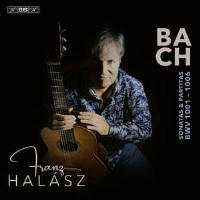Texte paru dans: / Appeared in:
|
|
|
|
|
|
Fans of German guitarist Franz Halász’s take on Bach’s so-called Lute Suites (9/19) and his earlier recording of the three Solo Violin Sonatas will be very pleased indeed with this latest release of Bach’s complete Sonatas and Partitas for solo violin, all newly arranged by Halász for classical guitar. As fellow guitarist Tilman Hoppstock – himself a superb Bachian – writes in his formidably detailed booklet notes: ‘The guitar, a very versatile instrument (polyphony, melodiousness, dynamics and timbres), is ideally suited to present the complexity of Bach’s works in the best possible way.’
There are, however, two ways to approach the transcription or arrangement of Bach’s solo violin music on the classical guitar. One is to follow Bach’s general practice and fill out the harmonies to taste as though for a lute or keyboard; that is to say, in improvisatory, figured-bass style. The other, as we find here, is consciously to honour the spare, linear nature of the violin originals and merely add the odd bass note here and there to, as Hoppstock writes of Halász’s arrangements, ‘expand the tonal range and support the harmonic framework’.
This is especially suited to Halász’s favouring on the one hand speeds so fast as to blur any denser textures and a marked cantabile presentation with generous rubato and feeling for the pure timbre of each tone. Any additional rhythmic and melodic complexity – which anyway generates harmonic tension – arrives courtesy of Halász’s lavish ornamentation, though it is never as lavish as Hoppstock’s or, for that matter, Eliot Fisk’s.
Halász chooses to place each partita before the following sonata, to great effect. The B minor Partita, with its dances and attendant ‘doubles’, immediately offers a rich panoply of virtuosic opportunities, Halász effectively shadowing the theme-and-variation pattern with a mixture of reflection and extravagance. It’s a generative strategy that pushes out into sequences such as the G minor Sonata’s Siciliano and following Presto, and the C major Sonata’s Largo and Allegro assai, yes; but most of all in the Second Partita’s Chaconne, which perhaps unsurprisingly finds Halász by turns intensely cerebral and unabashedly lyrical, if not ecstatic.
Then again, Bach’s music tends to have that effect on people, don’t you think? |
|




